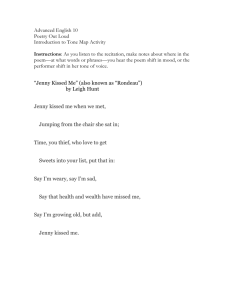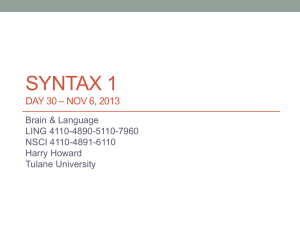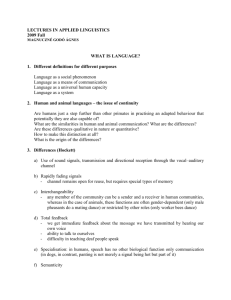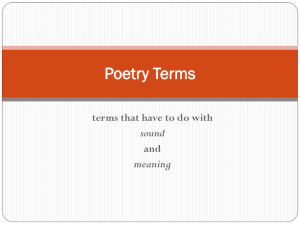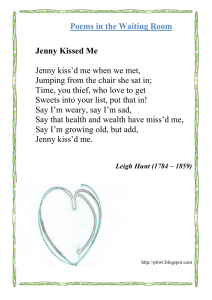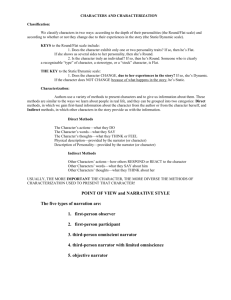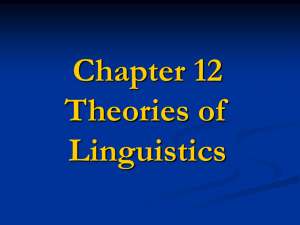Brain & Language slides
advertisement
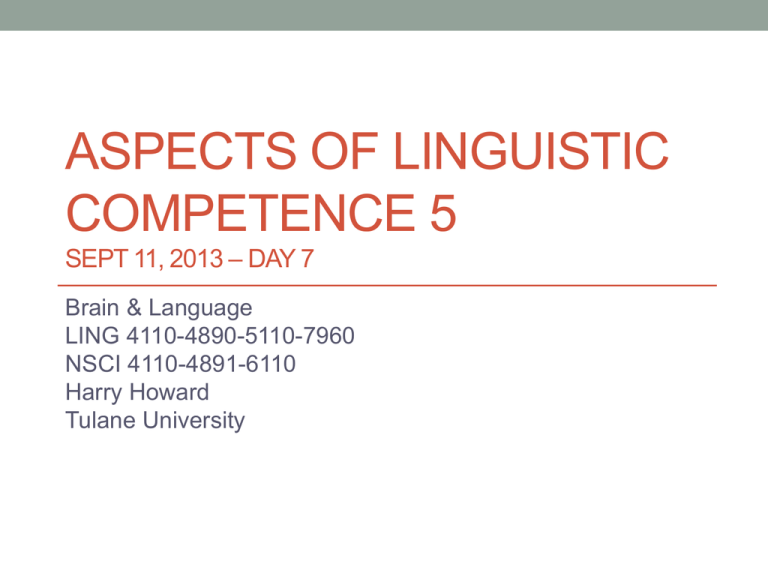
ASPECTS OF LINGUISTIC COMPETENCE 5 SEPT 11, 2013 – DAY 7 Brain & Language LING 4110-4890-5110-7960 NSCI 4110-4891-6110 Harry Howard Tulane University 9/11/13 Brain & Language - Harry Howard - Tulane University 2 Course organization • The syllabus, these slides and my recordings are available at http://www.tulane.edu/~howard/LING4110/. • If you want to learn more about EEG and neurolinguistics, you are welcome to participate in my lab. This is also a good way to get started on an honor's thesis. 9/11/13 Brain & Language - Harry Howard - Tulane University 3 Review • Last time, we discussed: • Thematic roles • Indefiniteness & specificity • (Pronominal) reference • Tense, aspect & modality • We left out the following, which you can read about on your own: • Deixis • Assertion & presupposition 9/11/13 Brain & Language - Harry Howard - Tulane University 4 ASPECTS OF LINGUISTIC COMPETENCE Ingram §2: mainly syntax 9/11/13 Brain & Language - Harry Howard - Tulane University 5 What are the parts of speech/syntactic categories? • Major/content categories • noun • verb • adjective • adverb • preposition/postposition? • Minor/functional categories • determiner: article, quantifier, demonstrative • pronoun • negation • conjunction: coordinating, subordinating • auxiliary verb? • Interjection 9/11/13 Brain & Language - Harry Howard - Tulane University 6 Words group to together to form phrases • What are the thematic roles of "Mary" and "John" in "Mary kissed John"? • Mary is Agent (and subject) • John is Patient (and direct object) • What goes before, or can be the Agent of, "kissed John"? • Mary kissed John. • She kissed John. • That girl kissed John. • The tall girl kissed John. • The girl over there kissed John. • A girl that you don’t know kissed John. 9/11/13 Brain & Language - Harry Howard - Tulane University 7 Restatement of subject data as NP • Answer • A word that is ‘nouny’, or a group of words that contain a noun; it does not matter which one. • We want a way to generalize over all of these possibilities, and the infinite number of alternatives that we can think up. • Let’s do this by calling it a noun phrase or NP. • An NP goes before, or can be the Agent of, "kissed John" • [NP Mary] kissed John. • [NP She] kissed John. • [NP That girl] kissed John. • [NP The tall girl] kissed John. • [NP The girl over there] kissed John. • [NP A girl that you don’t know] kissed John. 9/11/13 Brain & Language - Harry Howard - Tulane University Words to phrases 2 • What goes after, or is the Patient of, "John kissed"? • John kissed Mary. • John kissed her. • John kissed that girl. • John kissed the tall girl. • John kissed the girl over there. • John kissed a girl that you don’t know. • Answer • The same ‘nouny’ thing as before. • So let’s also call it a NP. 8 9/11/13 Brain & Language - Harry Howard - Tulane University 9 Restatement of object data as NP • An NP goes after, or is the Patient of, "John kissed": • John kissed [NP Mary]. • John kissed [NP her]. • John kissed [NP that girl]. • John kissed [NP the tall girl]. • John kissed [NP the girl over there]. • John kissed [NP a girl that you don’t know]. • The structure of our sentence now looks like this: • NP kissed NP. 9/11/13 Brain & Language - Harry Howard - Tulane University 10 NPs get around • English treats NPs as units, in the sense that they can appear in different parts of a sentence: a. b. c. d. e. Which girl kissed John? ~ Which girl did John kiss __? THAT girl kissed John. ~ THAT girl, John kissed __. Not even Mary kissed John. ~ Not even Mary did John kiss __. That girl is who kissed John. ~ That girl is who John kissed __. Who kissed John is that girl. ~ Who John kissed __ is that girl. 9/11/13 Brain & Language - Harry Howard - Tulane University 11 More phrases • But it seems to be that ‘kissed NP’ is a unit, too: 1. Kiss Mary, I would never do. 2. *Kiss, I would never do Mary. 3. What John did was kiss Mary. 4. *What John did Mary was kiss. 5. What did John do? –– Kiss Mary. 6. *What did John do Mary? –– Kiss. 7. John said he would kiss Mary, and he did so. 8. #John said he would kiss, and he did Mary. • Let’s call this new unit VP, so our sentence looks like this: • NP [VP kissed NP] • By the way, how do you know which ones are bad? • Because you are an expert in the grammar of your native language. 9/11/13 Brain & Language - Harry Howard - Tulane University 12 A bigger unit • The structure that we just saw covers a whole sentence, and it would be convenient to point this out in some way. • So let us just make up a new unit, say ‘S’ for sentence: • [S NP [VP kissed NP]] • Many people find it hard to keep up with all the labels and brackets, though, so linguists came up with an alternative, the tree structure: S NP VP kissed NP 9/11/13 Brain & Language - Harry Howard - Tulane University 13 Compositionality • Compare these next two sentences: 1. Mary kicked the mule. 2. Mary kicked the bucket. • #2 has two readings a. Mary applied force to the bucket with her foot. b. Mary died. • In the (a) reading, the sentence means what the sum of its words mean; in the (b) reading, it means something special, not predictable from the individual words. • This happens in morphology, too: a. b. the past tense of depart: departed the past tense of go: *goed, went • We call the (a) readings compositional, while the (b) readings are non-compositional or lexical. 9/11/13 Brain & Language - Harry Howard - Tulane University 14 More on kicking the bucket • Almost any change, no matter how minor, makes "kick the bucket" lose its non-compositional meaning: 1. 2. 3. 4. 5. Mary kicked the buckets. Mary kicked a bucket. Mary kicked that bucket. Mary kicked the pail. Mary kicked the big bucket. 9/11/13 Brain & Language - Harry Howard - Tulane University 15 ASPECTS OF LINGUISTIC COMPETENCE Ingram §2: left-overs 9/11/13 Brain & Language - Harry Howard - Tulane University Linguistic model, Fig. 2.1 p. 37 Discourse model Sentence level Word level Syntax S E M A N T I C S Sentence prosody Morphology Word prosody Segmental phonology production Segmental phonology perception Articulatory phonetics Speech motor control Acoustic phonetics Feature extraction INPUT 16 9/11/13 Brain & Language - Harry Howard - Tulane University 17 Linguistic model, Fig. 2.1 p. 37 Discourse model Sentence level Word level S E M A N T [S [NP mεɹi] [VP kɪst] [NP ʤan]] I C S [mεɹi] [kɪst] [ʤan] Segmental phonology production /mεɹikɪstʤan/ Articulatory phonetics Speech motor control bilabial - mid - alveolar nasal - front - flap [mεɹikʰɪstʤan] 9/11/13 Brain & Language - Harry Howard - Tulane University I-language vs E-language • In 1986, Noam Chomsky proposed a distinction between I-Language and ELanguage. • I-language mean ‘internal language’ and is the mentally represented linguistic knowledge that a native speaker of a language has, and is therefore a mental object — from this perspective, most of theoretical linguistics is a branch of psychology. • E-Language or ‘external language’ encompasses all other notions of what language is, for example that it is a body of knowledge or behavioral habits shared by a community. Thus, Elanguage is not itself a coherent concept, and Chomsky argues that such notions of language are not useful in the study of innate linguistic knowledge. 18 9/11/13 Brain & Language - Harry Howard - Tulane University NEXT TIME Ingram §3: Neuroanatomy of language ☞ Go over questions at end of chapter. 19

